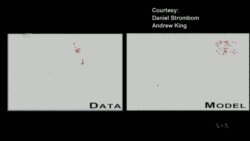Sheepdogs have something to teach people about crowd control.
A new study looks at what sheepdogs do naturally with their flocks to come up with a computer model that can recreate their behavior and apply it to situations well beyond the pasture.
A team of European researchers outfitted a sheepdog and 46 sheep with small GPS devices to chart their interaction. Co-author Andrew King of Swansea University in England says it provided really fine scale data on their movement and their trajectories over time.
The study revealed that the dog follows two basic rules, depending on the behavior of the sheep.
“Essentially the dog positions itself behind the flock if they are moving forward and it just stays there," King explained. "And if those white fluffy things that it is looking at become too sparse with gaps between them, then he will move towards the edge and start collecting those that are starting to move away from the rest of the flock.”
The scientists created a computer model to mimic that behavior.
“What emerges from the model is that the dog or the shepherd starts to weave behind that flock, which is exactly what we see in the real data,” King said.
Story continues below video:
This video animation, narrated by Andrew King, shows the real data from GPS devices affixed to the sheepdog and 46 sheep and a simulation model for the dog and same number of sheep.
In the sheepdog-inspired model, a single shepherd could herd a flock of some 100 plus individuals, or more than twice the number of other models.
In the future, King says, the work could be applied to computer or robotic systems to control crowds, move livestock, keep animals out of sensitive areas or even clean up the environment.
The research is published in the Journal of the Royal Society Interface.












